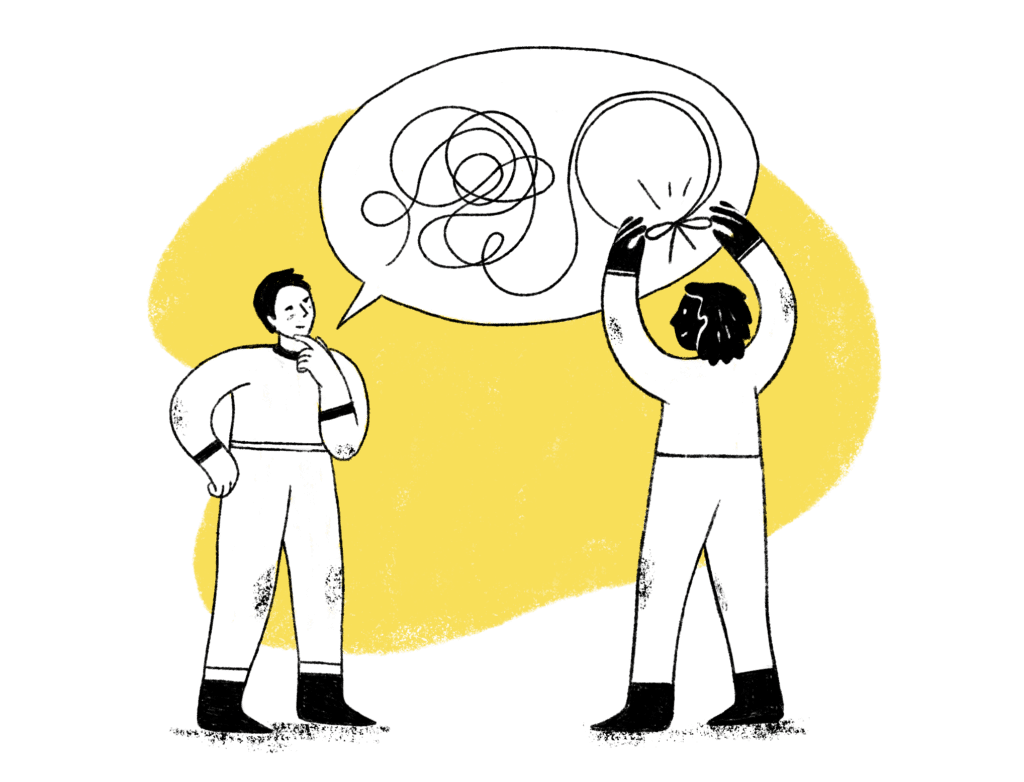
14 November 2025
7 min.
Communication au travail
21 November 2025
8 min.

Bringing up underperformance is a bit like delicate surgery: you need to get right to the heart of the issue without damaging what’s already working well. When someone isn’t meeting expectations, it’s about more than just productivity. It can stir up frustration among teammates, a sense of unfairness, and create a tense atmosphere.
So how can you have the conversation with empathy and impact—without turning it into an awkward stare-down? Here are some practical ways to approach the situation with respect, courage, and kindness.
Before sounding the alarm, take time to understand what you’re seeing. Is it a temporary dip in energy? A project that turned out more complex than expected? Or a real performance issue that’s been dragging on?
Here are some signs to watch for:
According to a Harvard Business Review study, workplace performance is often shaped by external factors like stress or unclear expectations. (1) So before reacting—dig a little deeper.
Learn how to set your priorities, deal with the unexpected, and speak up about your limits—without guilt

If your employee is struggling, were the instructions crystal clear from the start? We often assume everything’s understood—but in reality, that’s not always the case.
Here are some go-to actions:
✔ Review the goals together and make sure they’re fully understood.
✔ Use SMART goals (specific, measurable, achievable, realistic, and time-bound).
✔ Explain how the employee’s work fits into the bigger project or team objectives.
A McKinsey study found that 70% of employees perform better when they clearly understand their role and what’s expected of them. (2)
Learn how to turn everyday challenges into opportunities for collaboration and success!

There are a thousand and one reasons why someone might be underperforming:
But hold off on putting on your detective hat just yet. Our unconscious biases can lead us to quick—and often wrong—conclusions. For instance, we might assume someone “lacks initiative,” when in fact they’re feeling excluded or going through a tough time.
What can you do instead?
✔ Step back and stay curious: ask open-ended questions like “How are you feeling about your tasks these days?”
✔ Look at the work environment: is this an isolated issue, or are others on the team experiencing something similar?
✔ Remember: your interpretations aren’t facts. Often, it’s through non-judgmental listening that the real story comes out.
According to Gallup, 85% of employees feel more engaged when their manager takes time to talk through their work-related challenges. (3)
Learn how to recognize common workplace biases—and how to work around them

Giving feedback is an art. Too blunt, and it stings. Too vague, and it misses the point. The goal? Be clear, respectful, and action-oriented.
Instead of hiding the tough stuff between two compliments (goodbye, sandwich method!), go for a more direct and authentic approach. Your employees don’t need to be handled with kid gloves—they need kind clarity, not detours.
Here’s a more honest and effective approach:
✔ Describe what you’ve noticed, without judgment: “I’ve noticed some tasks are taking longer than expected.”
✔ Share your intention: “My goal is for us to figure out what might help make things easier for you.”
✔ Invite dialogue: “How are you seeing things on your end? Is there anything getting in your way?”
And most importantly: good feedback isn’t a monologue—it’s a conversation. One that opens the door to real adjustments, greater autonomy… and long-lasting trust.
Move past the discomfort and master the art of feedback!

No one likes being told to “do better” without explanation or support. To move forward, employees need a clear direction—and to feel supported along the way.
That’s where your coaching mindset comes in. Instead of dictating what to do, involve the person in the process. Together, you can identify what needs to change—and how to make it happen.
✔ Set realistic goals and concrete steps with your employee.
✔ Identify useful resources: training, mentoring, tools—or even a reshuffling of tasks.
✔ Plan regular check-ins to stay on track—without falling into micromanagement. (The idea is support, not constant pressure.)
When someone helps build their own development plan, they’re much more likely to stick with it. And you strengthen your role as a manager-coach—the kind who guides without taking full control.
Support more effectively—and watch your team grow in autonomy, confidence… and results!

Few things are more discouraging than putting in effort and getting zero recognition. On the flip side, noticing and acknowledging progress—even small steps—can make a real difference. It boosts motivation, a sense of accomplishment, and confidence.
Keep this in mind:
✔ Thank someone for the progress you’ve noticed in their work.
✔ Highlight team progress during a meeting or in a quick thank-you message (no need to overdo it—just be sincere).
According to Gallup, people who receive regular recognition are 4 times more likely to be engaged at work, and 3 times more likely to stay with their organization. (4)
Discover the lasting impact of non-monetary recognition!

If, despite your efforts, the situation stays the same, it may be time to consider more structured measures:
According to a study by the Society for Human Resource Management (SHRM), over 60% of struggling employees show signs of improvement with the right kind of follow-up. (5)
Learn how to handle tough conversations for constructive results!

No one enjoys dealing with underperformance. But with the right instincts—and above all, the right people skills—it’s absolutely possible, without drama or discomfort.
By staying clear, offering real support, and recognizing effort, you create a safe environment where improvement doesn’t just feel possible—it feels natural. And that’s where soft skills really shine: active listening, empathy, compassionate communication… These are the abilities that help you navigate the grey zones of daily work with both tact and impact.
Let’s be honest—more than once, a struggling employee has become a strong, engaged performer with the right support. Sometimes, all it takes is planting the seed at the right time—with the right relational tools.
A healthy work environment is more than just the absence of tension. It’s a place where communication flows, collaboration happens naturally, and everyone feels respected and valued.
Recognizing the signs of a toxic workplace is the first step to addressing the issue. But the real challenge is going further—building a culture where everyone can thrive and contribute fully to collective success.
At Boostalab, we know that transforming workplace culture doesn’t happen overnight. That’s why we offer concrete solutions to help you create lasting, positive change in your organization.
✔ Le Lab: Our online learning platform is designed to make learning engaging and flexible. Interactive courses available anytime, anywhere.
✔ Interactive team training paths: Immersive learning experiences that span several weeks, combining workshops with hands-on practice.
✔ Training boosts: A fun, interactive group workshop that helps build and reinforce key behaviours in just 30 days.
✔ Ready-to-train kits: Practical, engaging content that’s easy to implement directly in your LMS.
Not sure which soft skills training is right for you? Take the quiz and find the perfect fit!
1. Goler, L., Gale, J., Harrington, B., & Grant, A. (2018). Why people really quit their jobs. Harvard Business Review.
2. McKinsey & Company. (2022). The Future of Work. McKinsey Global Institute.
3. Gallup. (2021). State of the Global Workplace: 2021 Report. Gallup Press.
4. Gallup (2023). From Praise to Profits: The Business Case for Recognition at Work. Gallup Press.
5. Society for Human Resource Management. (2022). State of the Workplace Study 2021–2022. SHRM.
Blog

14 November 2025
7 min.

7 August 2025
5 min.

2 June 2025
8 min.